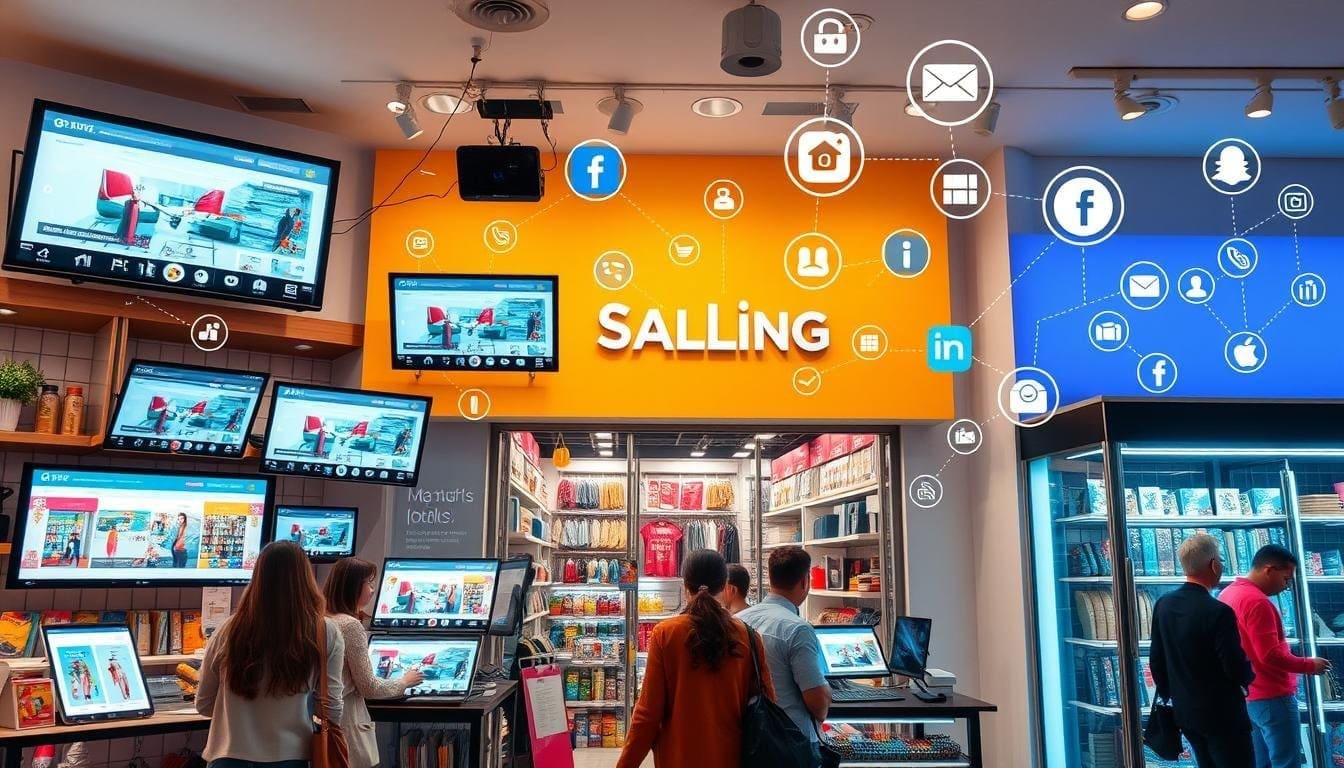In today's competitive world, multi-channel selling is key for small retailers. It helps them reach more people and boost sales. This article will explore how multi-channel selling can help small businesses grow.
By using different platforms, small retailers can attract more customers. This leads to better sales and more profits. In fact, retail e-commerce grew by 32% from 2019 to 2020, showing the power of multi-channel selling1.
Also, about 75% of retailers say they sell more when they use multiple channels2. This shows how effective multi-channel selling can be.
Key Takeaways
- Multi-channel selling allows access to a wider customer base.
- Enhanced customer engagement can lead to increased loyalty.
- Data analytics improve inventory management and marketing strategies.
- Adopting multiple channels can boost overall sales and revenue.
- Operating across various platforms helps differentiate a brand in the marketplace.
Understanding Multi-channel Selling
Multi-channel selling is a key strategy for today's retailers. It lets small businesses connect with customers on different platforms. This boosts sales and customer interaction.
This strategy uses various channels like physical stores, online marketplaces, and social media. It helps businesses reach more customers and overcome traditional barriers.
What is Multi-channel Selling?
Multi-channel selling greatly impacts e-commerce growth. Studies show that 52% of companies use three to four channels. Also, 72% of customers prefer to interact with businesses through multiple channels3.
For B2B companies, using multiple channels can increase ROI by 24%3. But, 89% of businesses face challenges in managing data across channels. This can cause sales and marketing efforts to be out of sync3.
Effective multi-channel selling is about giving customers a consistent experience. Yet, 71% of Gen Z and 51% of Millennials find new products on social media4. Providing excellent customer service is key, as 93% of customers are more likely to return if they receive great service4.
In today's competitive market, small retailers must focus on quality product information. This detail is important for sales, as customers want clear shipping costs and product listings. Also, 63% of consumers start their searches on Amazon, with 55% of Amazon's sales coming from third-party sellers5.
Grasping the concept of multi-channel selling is vital in today's retail world. By making it a core part of their strategy, small retailers can improve customer interaction and boost their e-commerce success.
Benefits of Multi-channel Selling for Small Retailers
Small retailers gain a lot by selling through multiple channels. This approach helps them reach more customers and sell more products. It also makes customers happier by giving them more ways to buy.
Key Advantages
Multi-channel selling changes how small businesses work. They use social media to talk to customers better. Sites like Facebook and Instagram help sell more and show off products, making them key for happy customers6.
In 2023, selling through many channels made over $575 billion. This shows how it can help small businesses grow. They can sell to more people and build stronger relationships, leading to more sales. Now, 89% of shoppers look at different places before buying, showing why being in many places is important7.
But, there are also challenges. Keeping track of stock is a big deal for multi-channel sellers. They need good systems to avoid selling too much or running out of stock6. This careful stock management helps keep sales up and customers happy by ensuring orders are filled on time.
Market Statistics and Trends
The world of e-commerce is changing fast, bringing new market trends and statistics to the table. Businesses that sell on multiple channels see big boosts in sales and customer interaction. For example, those selling on three or more channels make 143% more than those selling on fewer8.
More and more, people want to see ads on different platforms like email and social media. Almost 77% of consumers like getting messages this way9.
Current Trends in E-commerce
Live selling is becoming a big deal in e-commerce, changing how we interact with customers. About 72% of shoppers want to talk to brands on different platforms before buying9. Also, 60% of marketers think mixing channels can make customers happier and more engaged9.
As people's tastes change, live selling is likely to grow. It's interactive, which meets what customers want.
Platforms like Amazon show how important it is to sell on many channels. Amazon has 38% of the U.S. market10. I think using new marketing ideas is key for businesses to stand out. Keeping inventory right across all sales channels is also vital for happy customers and loyal fans8.
| Statistic | Value |
|---|---|
| Retail Revenue Increase (3+ Channels) | 143% |
| Consumer Preference for Multi-channel | 77% |
| Retail Market Share of Amazon | 38% |
| Companies Utilizing Multi-channel Strategies | 21% Revenue Increase |
| Customer Satisfaction Rate due to Multichannel | 60% |
Types of Sales Channels Available
Knowing the different sales channels is key for better retail strategies and more profit. Retailers can pick from online and offline channels. Each offers unique chances and meets various customer needs.
Overview of Sales Channels
There are mainly two types of sales channels: online and offline. Offline channels include traditional stores and pop-up shops. These physical spaces let retailers connect with customers in a lively way.
Online channels have grown a lot in importance. E-commerce sites like Shopify reach customers worldwide. Online marketplaces like Amazon and eBay attract millions every day. Social media and mobile apps also help brands talk directly to people. In 2020, online retailers made over $350 billion, showing the strength of online and offline channels11.
Most shoppers use more than one channel for buying things12. This makes a strong case for using many channels. With the eCommerce market expected to hit US$4.48 trillion this year, it's more important than ever to use different sales channels13.

| Sales Channel | Type | Advantages |
|---|---|---|
| Brick-and-Mortar Stores | Offline | Personal interaction, immediate product access |
| Pop-Up Shops | Offline | Temporary engagement, targeted location |
| Amazon | Online | Large audience, trusted platform |
| Shopify | Online | Customizable store, robust e-commerce features |
| Social Media | Online | Direct engagement, community building |
| Mobile Applications | Online | Convenience, personalized experiences |
In summary, using a mix of sales channels helps retailers reach their audience better and increase sales. By knowing what each channel does best, businesses can make strategies that fit the latest trends.
Digital Sales Channels and Their Importance
In today's world, digital sales channels are key to connecting retailers with more people. Online marketplaces and e-commerce sites help businesses reach customers who don't visit physical stores. Being visible on many platforms makes shopping better and boosts sales.
Emphasizing Digital Platforms
Looking into digital sales channels, I see Amazon and eBay are big for small retailers. Over 50% of buyers start their search on Amazon, showing its big role14. E-commerce sites let retailers control the shopping experience and brand. Direct sales channels include websites and apps, while indirect ones are social media.
Social media shopping is growing fast. Two out of three shoppers worldwide bought something on social media last year. This shows how important social commerce is15. It makes buying easy and natural for people who already use these platforms.
Using digital sales channels has big benefits. Shoppers who use many channels spend more than those who don't14. Businesses that use many channels can reach more people. This helps keep profits up and is a smart move. Learning about online selling strategies is key to staying ahead in the fast-changing market.
| Channel Type | Advantages | Disadvantages |
|---|---|---|
| Direct Sales Channels | Control over customer experience, higher profit margins | Higher setup costs, limited reach |
| Indirect Sales Channels | Wider reach, tapping into established customers | Less control over customer experience, additional fees |
| Social Media Platforms | Enhanced engagement, influencer partnerships | Dependence on platform algorithms, intense competition |
Using digital sales channels well can increase customer interaction and sales14. By using different platforms, I can make shopping better and meet today's consumer needs.
Physical Sales Channels and Their Relevance
Exploring retail, the value of physical sales channels is clear. Even with digital growth, brick-and-mortar stores are key for a real shopping experience. People want to touch products and make choices quickly.
Role of Physical Stores
About 73% of shoppers like using different ways to buy, showing the value of both online and offline stores16. In-person shopping boosts sales and builds brand loyalty. It's all about personal service and trust, which can increase customer loyalty by up to 91%16.
Physical stores are essential in today's shopping world. They offer unique benefits that online stores can't match. A study found that 42% of retail leaders spend a lot on omnichannel marketing16. Small businesses also focus on social media, spending about 67% of their marketing budget on it17. It's important to use both digital and physical channels to meet all shopping needs.
Multi-channel Selling for Small Retailers: Best Practices
Small retailers need to follow the best practices for multi-channel selling to boost their sales. They should understand how different people shop to offer a great experience everywhere. It's key to use data to improve marketing and make sure customer service is smooth.
Strategic Implementation
Keeping a consistent brand image on all platforms is a top tip. This builds trust and makes your brand more recognizable. With more people shopping online, having a mobile-friendly site is a must18.
Also, using big platforms like Amazon and eBay can help you reach more customers18. Keeping track of stock levels in real-time is also important. This way, you can avoid running out of products on any platform1819.
Using social media like Instagram and Facebook can also help. It makes it easier for customers to move between shopping online and offline19. By embracing these trends, small businesses can reach more people and increase sales.
Challenges in Implementing Multi-channel Selling
Starting to sell on multiple channels can bring new chances for small shops to grow. But, it also brings big challenges. Managing stock well is a major problem. Shops often face issues like having too much stock and not knowing what's in each place.
Trying to manage everything manually can lead to big problems. It can make operations less efficient.
Common Obstacles
Selling on sites like Amazon and eBay can make it hard to keep customers happy. Keeping track of stock across all places is a big challenge. If stock levels are wrong, it can mean lost sales.
Small shops need to be ready for the complex tasks of selling on many channels. Using data from different places to improve stock and service is key. But, many shops find it hard to use this data well.

Also, the cost of selling on many channels is high. There are costs for setting up, making things special, and hiring more people. Starting small, with just a few channels, can help manage these costs better.
For more tips on managing stock across many channels, see this resource on inventory solutions.
“The key to navigating the challenges of multi-channel selling lies in effective planning and utilizing the right tools to manage operational complexities.” – Industry Expert
| Challenge | Details |
|---|---|
| Inventory Management | Overstocking, manual management, lack of visibility |
| Customer Experience | Difficulty maintaining consistent support across platforms |
| Cost Implications | Setup costs, customization, staffing expenses |
| Operational Complexity | Challenges in coordinating multiple sales channels |
Thinking about the challenges of selling on many channels, I see how important careful planning and the right tools are. Good strategies can help a shop succeed on many channels. They can also reduce the risks of managing stock and operations2021.
Expert Opinions on the Future of Multi-channel Selling
Industry leaders paint a clear picture of the future of multi-channel selling. They all agree: the future of retail depends on multi-channel strategies. The pandemic has shown us how important it is to offer smooth shopping experiences.
According to Wharton, 66% of online shoppers use multiple channels for their purchases. This shows a big shift towards engaging with customers in many ways22.
Insights from Industry Leaders
E-commerce sales hit $2.3 trillion last year and are expected to reach $4.88 trillion by 2021. Brands must meet the modern consumer's needs23. Experts say using multiple channels can increase revenue by 38%, 120%, and even 190%22.
Warby Parker is a great example. They mix direct-to-consumer and brick-and-mortar sales. This approach led to $600 million in sales, split evenly between both channels.
Retailers struggle to implement omni-channel strategies. They need to invest a lot in technology to offer a unified customer experience24. Amazon and eBay get over three billion visitors monthly in the U.S. This shows how tough the competition is24.
73% of retailers know multi-channel selling is key. They say a single-platform strategy won't cut it in today's market22.
Streamlining Inventory Management Across Channels
Managing inventory well is key for retailers selling through many channels. It stops overselling and stockouts that can cost sales. In 2020, Target showed how important it is to manage inventory well by fulfilling 95% of online orders from stores25.
As more retailers use different sales channels, cloud inventory solutions become more important. These tools update inventory in real-time, which is critical in busy online markets. Without this, overselling can happen, making inventory management harder26.
Inventory Solutions
Businesses use systems that track stock and sync it across sales platforms to manage inventory better. Tools like Order Shipment Management Systems and Automated Restocking Notifications boost efficiency. Many struggle with old inventory tracking methods, like manual ones, which can be less accurate27.
Cloud inventory solutions help solve these problems and ensure a smooth shopping experience across all channels.
Tools like demand forecasting and ABC Inventory Analysis help manage stock levels for better finances27. For example, accurate demand forecasting lets retailers adjust stock to meet demand without overstocking. This improves customer happiness and helps keep profits up in a competitive market.
Marketing Strategies for Multi-channel Selling
Creating effective marketing strategies for multichannel selling is key to reaching different customers. Tailoring marketing to each channel's unique needs boosts success. This way, brands can build stronger connections and get more people involved.
Tailoring Marketing Approaches
Each platform needs its own strategy. For example, e-commerce sites need detailed product info, while social media loves quick, eye-catching ads. This makes shopping better for everyone.
Studies show that using many platforms helps businesses reach more people. This includes online stores, physical shops, social media, and apps. It makes shopping smooth and helps gather data to improve marketing28.
By 2020, multichannel online sales hit over $350 billion. This is expected to grow to 46% of all e-commerce by 202329. This shows how important it is to have strategies that meet these needs.
Brands need to make messages that speak to their audience on every channel. Gone are the days of one-size-fits-all marketing. Today, we need to tailor our approach to meet the diverse needs of customers28. For example, using physical stores lets brands connect with customers while also learning about their spending habits28.
As marketing evolves, with social commerce expected to reach $79.6 billion by 2025, brands must adapt29. With the right strategies and insights, businesses can not only keep up but thrive in the changing world of e-commerce.
| Year | Projected Sales | Market Share of E-commerce |
|---|---|---|
| 2020 | $350 billion | N/A |
| 2023 | N/A | 46% |
| 2025 | $79.6 billion | 5.2% |
| 2025 | N/A | 10.4% (Mobile Commerce) |
Leveraging Data to Enhance Customer Experience
In the world of multi-channel selling, using customer data is key to better customer experience. Knowing what customers like and how they shop helps retailers offer personalized experiences. By gathering data from social media and e-commerce sites, we learn which products customers want. This helps us make marketing plans that work well.
This data-driven method also helps us find out which channels are best. It lets us spot customers who might leave and keep them from doing so. This is a big part of any good strategy3031.
Importance of Customer Analytics
Using customer analytics helps my retail business make offers that really speak to customers. It lets us sort customers into groups for targeted campaigns. For example, tools like Klaviyo and Marsello help us make marketing that's just right for each customer. This leads to more engagement and keeps customers coming back30.
Also, collecting customer data is vital for knowing the Customer Lifetime Value (CLV). This shows how much money a customer can bring in over time. With this info, we can focus on the marketing that really pays off, keeping our business sharp and ready to adapt31.
Conclusion
Embracing multi-channel selling is key for small retailers to grow. It's not just a trend but a must for success. With 73% of customers using multiple channels, those who adapt will see big benefits32.
Using different sales channels can also make customers happier. Companies that offer the same experience everywhere see a huge jump in customer satisfaction33. As e-commerce keeps changing, those who invest in multi-channel strategies will thrive.
For small retailers, knowing how to sell through many channels is vital. It helps reach more customers and build lasting relationships. This is essential for growth in today's competitive world34.
FAQ
What is multi-channel selling?
What are the benefits of multi-channel selling for small retailers?
What types of sales channels should small retailers consider?
How important are digital sales channels in today's market?
What challenges do retailers face with multi-channel selling?
How can small retailers effectively manage inventory across multiple channels?
What marketing strategies should be used for multi-channel selling?
How can data analytics improve customer engagement in multi-channel selling?
Source Links
- Definitive Guide to Multichannel Selling — Katana – https://katanamrp.com/blog/multi-channel-selling/
- Multiply Your eCommerce Revenue With Multi-Channel Selling – https://www.coredna.com/blogs/multi-channel-selling
- Multichannel Selling – https://dealhub.io/glossary/multichannel-selling/
- How to Get Started With A Multichannel Selling Strategy | Plytix – https://www.plytix.com/blog/get-started-with-a-multichannel-selling-strategy
- Multichannel Selling: A Guide for Ecommerce Businesses – https://www.sellbrite.com/blog/multichannel-selling/
- What Is Multichannel Selling? [Key Benefits + Tips to Start] (2024) – Shopify – https://www.shopify.com/blog/multichannel-selling
- Ware2Go’s Complete Guide on Why Multichannel Selling Matters – https://ware2go.co/articles/the-importance-of-multichannel-selling/
- Multichannel Ecommerce: The Benefits of Selling on Multiple Platforms – https://www.fermatcommerce.com/post/multichannel-ecommerce-the-benefits-of-selling-on-multiple-platforms
- Compelling Multi-Channel Marketing Statistics for Success – https://profiletree.com/compelling-multi-channel-marketing-statistics/
- Amazon vs. Shein vs. Temu: Exploring Multichannel Selling for Sellers – https://www.carbon6.io/blog/exploring-multichannel-selling-for-sellers
- Multichannel Selling: How To Decide on Sales Channels for Your Business (2024) – Shopify – https://www.shopify.com/enterprise/blog/what-is-multi-channel-retailing
- 13 Best Sales Channels in 2024: Guide, Definition & Examples – https://www.close.com/blog/sales-channels
- Ecommerce Sales Channels for Multichannel Selling | Plytix – https://www.plytix.com/blog/ecommerce-sales-channels
- Multichannel Retailing 101: What It Is & Why You Should Use It – https://www.bigcommerce.com/articles/omnichannel-retail/multichannel-retail/
- 7 eCommerce Channels for Multichannel Selling 2024 – https://www.mayple.com/resources/ecommerce/ecommerce-channels
- A Comprehensive Guide to Multi-channel Selling – https://www.linkedin.com/pulse/comprehensive-guide-multi-channel-selling-fdryf
- 9 sales channels for effective selling | QuickBooks – https://quickbooks.intuit.com/r/growing-a-business/sales-channels/
- Multichannel Selling – A Complete Guide to Boost Your Sales – https://www.linkedin.com/pulse/multichannel-selling-complete-guide-boost-your-sales-ronald-robbins
- Multi-Channel Retailing: The Ultimate Guide to Engaging Customers On and Offline – https://koronapos.com/blog/multi-channel-retailing/
- 5 Common Multi-Channel Challenges and How to Overcome Them – https://www.sellbrite.com/blog/5-common-multi-channel-challenges-overcome/
- Multi-Channel Retailing: Definition, Benefits & Challenges | Zoho Inventory – https://www.zoho.com/inventory/academy/multichannel-selling/multi-channel-retailing.html
- Multi-channel Selling: Experience eCommerce At It's Full Potential – https://cedcommerce.com/blog/multi-channel-selling-ecommerce/
- Multi Channel Ecommerce Past Present Future – Listing Mirror – https://www.listingmirror.com/multi-channel-ecommerce-past-present-future/
- How to Grow in a Multichannel World – https://insight.kellogg.northwestern.edu/article/e-commerce-future-channel-strategy
- How to Do Multi Channel Inventory Management with One Simple Integration – https://accumula.com/test/blog/multi-channel-inventory-management
- Multichannel Inventory Management Done Right (2024) — Katana – https://katanamrp.com/blog/multichannel-inventory-management/
- Guide to Multi-Channel Inventory Management – https://www.knack.com/blog/multi-channel-inventory-management/
- Definitive Guide Multichannel Sales Strategy to Boost Sales – https://webappick.com/multichannel-sales-strategy/
- Multichannel Selling: How To Decide on Sales Channels for Your Business (2024) – Shopify Canada – https://www.shopify.com/ca/enterprise/blog/what-is-multi-channel-retailing
- Multi-Channel Selling: Marketing Strategies For Data-Driven Merchants – https://resources.marsello.com/blog/multi-channel-selling-marketing-strategies-for-data-driven-merchants
- Boost Your Multi-Channel Marketing Strategy With Data – https://breadcrumbs.io/blog/multi-channel-marketing-strategy/
- Multichannel Retailing: Definition, Benefits, Downsides and More – https://litcommerce.com/blog/multichannel-retailing/
- Using Multichannel Retailing to Unleash Your Ecommerce Potential in 2024 – https://www.shipbob.com/blog/multichannel-retailing/
- Multichannel Selling: How To Decide on Sales Channels for Your Business (2024) – Shopify Malaysia – https://www.shopify.com/my/enterprise/blog/what-is-multi-channel-retailing





